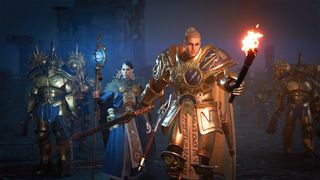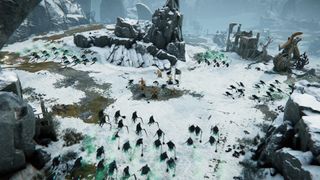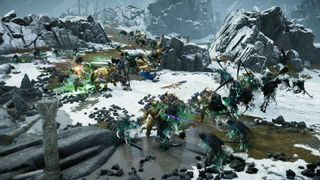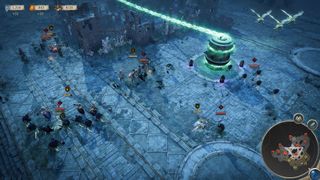An hour under relentless siege by orcs and angry ghosts in the world of Warhammer has me convinced that Realms of Ruin is the next great RTS campaign
Understanding the spirit of Frontier's new RTS, thanks to an army of spirits.

In Shyish, the Realm of Death, Nagash the Great Necromancer moulds the souls of the deceased into his personal army. Cursed with new forms that reflect their mortal sins, he creates endless hosts of wailing, suffering spirits known as the Nighthaunt. And then he sends them all to capture my bloody control points.
When this real-time strategy game set in the mythic fantasy world of Warhammer Age of Sigmar was announced, only two of the game's four factions were revealed: the shining warriors of the Stormcast Eternals, and the vicious, swamp-dwelling Orruk Kruleboyz. As I play through two of the game's campaign missions, I get to meet a third—and it's not a friendly introduction. As I attempt to hold three objectives—the bases of spectral chains I need to break to retrieve a powerful artefact—the Nighthaunt throw themselves at my heroic Stormcast in relentless waves.
This seems to be what, at its core, Realms of Ruin is all about: objective control. Though the two campaign missions I play are quite different conceptually—one, pushing into orruk-controlled territory, the other holding out against the aforementioned barrage of ghosts—they both essentially come down to seizing and holding ground against repeated enemy attacks. With little in the way of base-building or economy management, beyond being able to plop one of a limited set of structures on points you control, the focus isn't on how you make your armies, it's on how you use them to dominate the battlefield.
The result, at least in these campaign missions, is a feeling of constantly putting out fires. You can only have so many troops on the field at any given time, and to divide them across every point is to spread them too thin. But any point left undefended is vulnerable—if you don't have some backup standing ready to swoop over to it, it'll soon be lost. There's a constant ebb and flow of battle—your goal is to make sure it surges in your favour more often than against you.
There's a lot of real tension in these missions. The enemy keeps you under pressure—you can never just rest on your laurels or turtle up against invasion. But where in most RTS games, that would make it a gruelling test of your speed and micromanagement skills, Realms of Ruin's slower pace puts the focus on your tactical choices above all. It can take quite a long time for a unit to get from one end of the map to another, or between two vital points. That goes double for the hulking, heavily-armoured Stormcast. That means you have plenty of time to choose who's going where when the alarm goes up that a point is under threat—but it also means you'd better have made the right choice, because if you haven't, pivoting isn't going to be quick or easy.
Ghost of a chance

I'll be the first to admit I'm no expert when it comes to RTS games. I've been playing them since Warcraft 2, but I've never been any good at them—a fact made abundantly clear when the game's PR has to jump in mid-mission to offer some desperate tips for my stalemate against the undead. But despite my blunders, it's clear that Realms of Ruin is much more accessible than you'd usually expect from the genre. With a modest number of units to control, and the time to really consider where they were needed at any given moment, I never felt like the hole in my strategy was just not being able to click fast enough or not knowing the exact right order of commands to execute.
That suits the feel of Warhammer Age of Sigmar—both the very deliberate play of the tabletop game, but also the tone of the setting. Where the more widely known Warhammer Fantasy and Warhammer 40,000 setting emphasise grim futility, in Age of Sigmar, the light of hope burns in the darkness. The actions of small groups of heroes—or horrors—can change the course of history, and it certainly feels that way in Realms of Ruin when a handful of troops, deployed decisively at the perfect moment, hold the line just long enough to win you the game.
The biggest gaming news, reviews and hardware deals
Keep up to date with the most important stories and the best deals, as picked by the PC Gamer team.

Such a big, wild setting doesn't need to be undercut with a quip or a knowing remark, and melodrama fits the mythic fantasy better than fine nuance would.
Authenticity is a key aim for Realms of Ruin. Though Age of Sigmar may not be familiar to you as a PC player—it's one of Warhammer creator Games Workshop's newest settings, launched after the official demise of Warhammer Fantasy—Frontier Developments has clearly gone to great pains to be as faithful to the setting as possible. The chunky little units look like they walked straight off a wargamer's shelf, the battlefields look like art from an army book, and I even spotted trees that evoke specific Warhammer terrain sets.
My hands-on gives me some more time with another key part of that equation: the story. Leading into my two missions are cutscenes following the Stormcast Eternals and a wizard ally as they search for an artefact of power in the swamps of the Realm of Beasts. As the characters exposit and banter, the dialogue is earnest and a little cheesy—and honestly, that feels like the right approach. Such a big, wild setting doesn't need to be undercut with a quip or a knowing remark, and melodrama fits the mythic fantasy better than fine nuance would.
As soon as the wizard starts sinisterly talking about harnessing power and delving into arcane ruins, you might as well stamp "I'm Going To Turn Evil Later" on his forehead, but though the characters aren't subtle, they are likeable—particularly the Stormcast leaders, who, though they make look like fantasy Space Marines, have far more personality. The company's banner bearer is a particular highlight, sounding like a mystical Jason Statham as he points out that exploring the spooky ancient ruins might not be the best idea. Simple leads also allow plenty of space for efficient exposition, getting newcomers up to speed on the Mortal Realms in a way that will still feel true to the source material for die-hard Age of Sigmar fans.
Hammer time

Far from just a crowd of generic ghosts, they're misshapen, hunched monstrosities, each distorted into a form pleasing to Nagash.
That authenticity certainly extends to the Nighthaunt, too. Though I don't get to play them myself, my battle against them reveals that they're a versatile and surprisingly resilient horde, much like in the tabletop game. Far from just a crowd of generic ghosts, they're misshapen, hunched monstrosities, each distorted into a form pleasing to Nagash. From the Craventhrone Guard dragging around crossbows far too large for their wispy arms, to the huge and disgusting Mourngul that propels its legless torso around with just its gangly arms, to Awlrach the Drowner, a sinister boatman rowing his ethereal vessel across the battlefield, they're all completely charming in their horribleness—and each fill their own clear role in the faction's strategy.
As they assault my control points, I'm forced to constantly adapt. Clanking Chainrasps come at me in crowds, bogging down my more elite units—at first they're constantly slowing me down, until I'm tipped off that the Prosecutor's hammer-flinging area-of-effect attack is the perfect way to clear them out. Grimghast Reapers come in smaller numbers, but when they hit my line their scythe-swings wreak havoc—peppering them with crossbow fire from my Vanguard Raptors seems to be the best way to soften them up before the charge.
Counterplay in Realms of Ruin is kept pretty simple—there's an easy rock-paper-scissors mechanic that makes each of the three broad infantry types good against one type but weak against another, and it's relatively straightforward to get a sense of what each active ability is useful for (even if I needed some hints). Putting it into practice is the tricky part, especially when splitting your forces across your territory makes it difficult to have the right units in the right place at the right time.
Conquest quests

In the final game, set for a November 17 release date, your tactical prowess will be tested across a full campaign—in which you'll play multiple factions, not just the Stormcast—as well as against other players in multiplayer. Frontier also revealed to me a third mode: Conquest. This repeatable singleplayer mode puts me in mind almost of a roguelike. Each time you play, the game procedurally generates a simple campaign map of 1v1 battles for you. Along the way, random modifiers switch things up—I'm given examples of vastly reducing the vision distance of units, speeding up unit movement, or a strict time limit forcing you to win as fast as you can. Though I didn't get to try it myself, from what I've seen it seems another clever step towards accessibility—it means that, for those like me less adept at RTS play, there's ongoing solo content to play that's much less intimidating than going up against other players in multiplayer.
It's touches like this that make Realms of Ruin feel like more than just a throwback to the RTS golden age. Long-time genre fans will certainly feel some nostalgia—especially those who enjoyed the Dawn of War games. But there's a modern vision here too, one particularly aimed at making the push and pull of war the star of the show, and making that something even newcomers to the genre can enjoy.

Formerly the editor of PC Gamer magazine (and the dearly departed GamesMaster), Robin combines years of experience in games journalism with a lifelong love of PC gaming. First hypnotised by the light of the monitor as he muddled through Simon the Sorcerer on his uncle’s machine, he’s been a devotee ever since, devouring any RPG or strategy game to stumble into his path. Now he's channelling that devotion into filling this lovely website with features, news, reviews, and all of his hottest takes.
Most Popular


